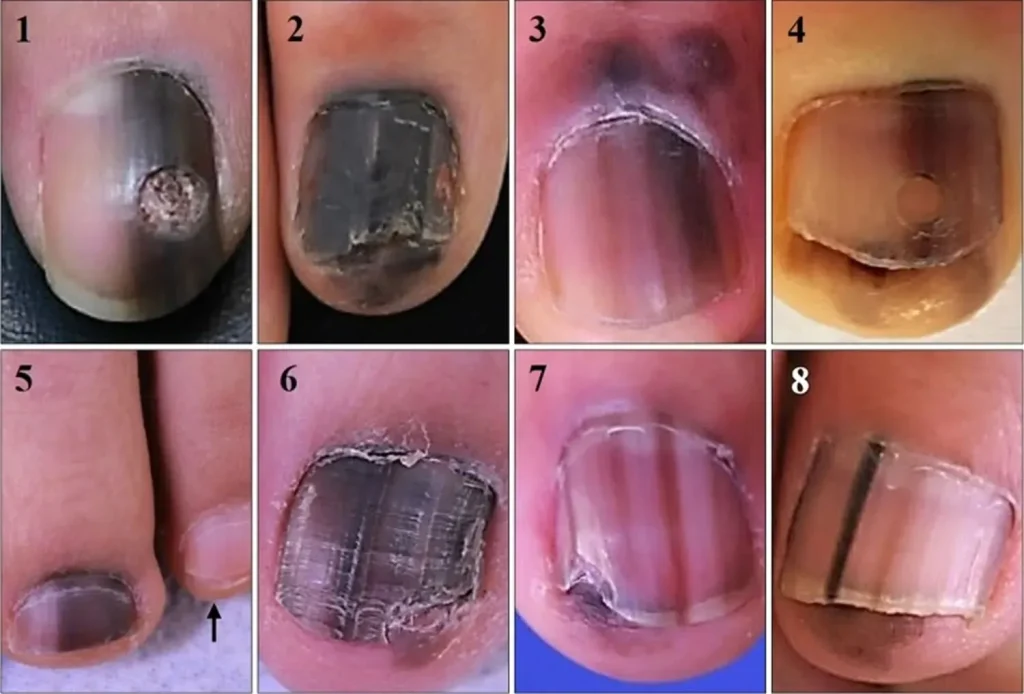Acral lentiginous melanoma is a rare but aggressive form of skin cancer that often goes unnoticed until it’s in advanced stages. Unlike more common melanomas, which typically appear on sun-exposed areas, this type manifests under the nails or on the palms and soles, making it crucial to recognize its symptoms early. Awareness of skin cancer symptoms like unusual discoloration, particularly in the nails, can be life-saving; it is essential to consult a healthcare professional if you notice any strange markings. Laura Jennings’ story is a stark reminder that even seemingly harmless toenail marks can signal serious health issues such as toenail cancer. Increasing melanoma awareness can help emphasize the importance of early detection of cancer to improve treatment outcomes and survival rates.
Acral lentiginous melanoma, often referred to as subungual melanoma, is a distinct variant of skin cancer that requires heightened vigilance and awareness. Many may mistakenly dismiss changes in their nails as common issues like a fungal nail infection or minor injuries. However, it’s important to understand that dark streaks or discoloration under the nails can also signify underlying malignancies. This type of melanoma is particularly notable for its atypical presentation and is not linked to sun exposure, highlighting the need for education around its symptoms. By promoting knowledge surrounding this rare form of skin cancer, we can encourage more individuals to seek timely medical advice and prioritize their health.
Understanding Acral Lentiginous Melanoma
Acral lentiginous melanoma is a rare but aggressive form of skin cancer that typically appears on the palms, soles of the feet, and under the nails. Unlike more common melanomas that are often linked to UV exposure, acral lentiginous melanoma occurs in areas that are less exposed to sunlight, making it a unique and insidious threat. Patients like Laura Jennings serve as important reminders that distinctive marks on the nails or skin can signal something far more serious than a typical bruise or fungal nail infection. Early identification of these symptoms is crucial for effective treatment.
Being aware of the signs of acral lentiginous melanoma plays a significant role in encouraging early detection of cancer. Typically, the first symptoms may include a dark streak or a discoloration under or around the nails, which can easily be misdiagnosed as a simple injury or an infection. It’s essential to consult a medical professional if these symptoms arise, as dismissal can lead to advanced stages of a dangerous illness. Educating oneself about melanoma awareness can be a pivotal factor in survival, just as it was for Laura when she decided to push for a face-to-face consultation when her symptoms persisted.
Signs and Symptoms of Skin Cancer
Skin cancer symptoms can vary widely, but some common indicators include changes to the skin such as unusual moles or growths, patches of discoloration, or persistent sores that don’t heal. Individuals often feel inclined to disregard subtle changes, attributing them to minor issues like a bruise or fungal nail infection. However, experts emphasize that being vigilant about skin changes is vital. Regular skin checks and awareness of changes, even in less visible areas like under toenails, are key steps toward early detection and treatment of skin cancer.
Another critical aspect of skin cancer is understanding its potential symptoms in the form of nail conditions. Much like Laura’s experience, a mark on the toenail that may first appear to be insignificant could actually be a harbinger of more severe health issues. As reported, many individuals only associate skin problems with moles on their bodies, but nail marks should also warrant attention. Melanoma awareness campaigns work hard to educate the public about these signs, arguing that knowing what to look for can save lives.
The Importance of Early Detection
The message from melanoma survivors like Laura Jennings underscores the necessity of early detection in the fight against skin cancer. Research shows that early identification significantly increases the chances of successful treatment and improved outcomes. For instance, if acral lentiginous melanoma is diagnosed early before it spreads, the survival rates can exceed 90%. This statistic emphasizes the importance of being proactive about any skin changes, rather than waiting for symptoms to worsen before seeking medical advice.
Regular medical check-ups and open communication with healthcare providers about skin changes are critical components of maintaining one’s health. Those with a history of skin cancer or other risk factors should prioritize skin examinations. Additionally, encouraging friends and family members to be vigilant about their skin health can foster a culture of awareness. As Ms. Jennings poignantly reminded us, ‘Early detection really is key,’ reinforcing the idea that taking a moment to examine skin changes can potentially prevent life-threatening situations.
Addressing Common Misdiagnoses
Misdiagnosis is a common occurrence in medical practice, particularly with conditions that share symptoms. Laura Jennings’ experience highlights how a seemingly innocuous mark on her toenail was initially misdiagnosed as a fungal infection. This underscores the importance of seeking a second opinion or further investigation when concerns persist. The potential for misdiagnosis can be deadly; thus, maintaining open dialogue with healthcare providers is essential when health issues arise.
Patients should feel empowered to advocate for their health. If a prescribed treatment, such as antifungal ointment for a suspected fungal nail infection, does not produce results, it’s crucial to pursue further evaluation. Being proactive and persistent can lead to timely discoveries of serious conditions, such as acral lentiginous melanoma. Healthcare professionals appreciate informed patients who are aware of their bodies and can discuss their concerns; it strengthens the care they provide.
Living with a Cancer Diagnosis
Receiving a cancer diagnosis can be a life-altering event, as experienced by Ms. Jennings. The emotional impact goes well beyond physical health, affecting relationships, daily routines, and mental health. For many, coping with the fear of a potentially terminal illness can lead to heightened anxiety and stress. Finding healthy ways to manage these emotions, seeking support groups, and engaging in therapy can be vital steps towards healing.
Moreover, many cancer survivors learn valuable life lessons about the importance of each moment. They often report a renewed appreciation for life’s simple pleasures, emphasizing the value of spending time with loved ones and pursuing happiness. Ms. Jennings exemplifies this attitude, focusing on herself and her son’s experiences despite the challenges she faces ahead. By sharing her journey, she helps others confront their fears and encourages a proactive approach to health.
Melanoma Awareness Campaigns
Melanoma awareness campaigns advocate for education on skin cancer, especially among at-risk populations. These initiatives aim to inform the public about the signs and symptoms of melanoma, including acral lentiginous melanoma, emphasizing preventive measures and the significance of regular skin checks. Campaigns that highlight personal stories, like Laura Jennings’, offer relatable experiences and raise awareness about the importance of early detection.
Events, social media outreach, and community health workshops are vital for spreading knowledge about skin cancer prevention and early detection. These campaigns stress the critical nature of monitoring changes in skin and nails and encourage individuals to consult healthcare providers when concerned. By increasing melanoma awareness, we can work collectively to reduce misdiagnoses and save lives through education and vigilance.
Understanding Fungal Nail Infections
Fungal nail infections, while common, can sometimes be mistaken for more serious issues such as skin cancer. Symptoms typically include discoloration, thickening, and crumbling of the nail, which may initially resemble signs of a bruise or even acral lentiginous melanoma. It’s crucial to differentiate between these conditions to ensure proper treatment and avoid complications. Understanding the characteristics of fungal infections can help patients make informed decisions regarding their nail health.
Individuals experiencing symptoms often opt for over-the-counter antifungal treatments, which may not always resolve the issue. This can lead to prolonged suffering and neglect of what may actually be a more serious problem like melanoma. Education about the risks of misdiagnosing nail conditions can empower patients to seek medical attention promptly if symptoms persist. A doctor’s evaluation of any abnormal nail condition is essential for accurate diagnosis and treatment.
The Role of Genetics in Skin Cancer
Genetics can play a significant role in an individual’s susceptibility to skin cancer, including forms like acral lentiginous melanoma. Certain genetic mutations can increase the risk of developing melanoma, which is important to consider, especially for individuals with a family history of skin cancer. Understanding one’s genetic predisposition can lead to more vigilant skin monitoring and early medical consultations, ultimately enhancing the prospects of successful treatment.
Research continues to evolve in the understanding of the genetic factors that contribute to melanoma, driving advances in personalized medicine. Genetic testing can help identify specific risks, enabling individuals to take preventive measures, such as more regular screenings and protective behaviors against sun exposure. Awareness of one’s genetic background can be transformative, translating into better health outcomes for families with a history of skin cancer.
Emotional Resilience After Cancer
Building emotional resilience after a cancer diagnosis is a critical part of recovery. Survivors like Laura Jennings highlight the emotional rollercoaster of facing mortality and the importance of support systems during such challenging times. Having a robust network of family and friends can foster a sense of hope and provide practical help through treatment and beyond. Mental health resources, such as therapy and support groups, can also empower survivors to navigate their feelings and fears.
Resilience also involves engaging in self-care and mindful practices that facilitate healing. Many survivors focus on healthy lifestyles, which can include balanced nutrition, regular exercise, and mindfulness techniques. Such changes may offer not only physical benefits but also contribute positively to one’s mental well-being. Embracing a resilient mindset enables individuals to cherish life more deeply and appreciate each moment, reinforcing the commitment to living fully after a cancer diagnosis.
Frequently Asked Questions
What are the early symptoms of acral lentiginous melanoma?
Early symptoms of acral lentiginous melanoma include any unexplained dark streaks or changes in the nail, often mistaken for a bruise or a fungal nail infection. It’s important to monitor these changes, as they may not always be painful. If you notice unusual markings or discoloration under your nails, seek prompt medical advice to rule out skin cancer.
How can I differentiate between a fungal nail infection and acral lentiginous melanoma?
Differentiating between a fungal nail infection and acral lentiginous melanoma can be challenging without professional help. A fungal nail infection typically causes discoloration, thickening, or crumbling of the nail. Conversely, acral lentiginous melanoma often appears as a dark streak under the nail that doesn’t improve over time and may worsen. If you’re unsure, it’s crucial to consult a healthcare provider for an accurate diagnosis.
What steps should I take if I find strange marks on my toenails?
If you find strange marks on your toenails, the first step is to schedule an appointment with your doctor. It’s essential to discuss your concerns openly, especially if the marks persist or change. Early detection of acral lentiginous melanoma can significantly improve treatment outcomes, so do not delay in seeking medical attention.
How prevalent is acral lentiginous melanoma among skin cancers?
Acral lentiginous melanoma accounts for approximately 3% of all melanoma diagnoses. While it is a rare form of skin cancer, it is considered highly aggressive and can be deadly if not detected early. Awareness and understanding of all forms of skin cancer symptoms, including those relevant to acral lentiginous melanoma, are vital for timely treatment.
What should I know about melanoma awareness and prevention?
Melanoma awareness is crucial, as it is a leading cause of skin cancer deaths. Key prevention strategies include regular skin checks, being vigilant about changes in moles or nails, and seeking timely medical advice if concerns arise. Education on skin cancer symptoms, including those associated with acral lentiginous melanoma, contributes to early detection, improving survival rates.
Is acral lentiginous melanoma linked to sun exposure?
Unlike other types of melanoma, acral lentiginous melanoma is not typically associated with sun exposure. The exact cause remains unknown, but it is recognized as a serious form of skin cancer that can appear on the palms of the hands, soles of the feet, and under the nails. Understanding this helps raise awareness about non-sun-related skin cancer risks.
How can I support early detection of acral lentiginous melanoma?
Supporting early detection of acral lentiginous melanoma involves educating yourself and others about skin cancer symptoms, particularly those that may go unnoticed, like dark streaks under nails. Regular self-examinations and encouraging friends and family to seek medical advice for unexplained skin changes can significantly impact outcomes.
| Key Point | Details |
|---|---|
| Diagnosis Delay | Initially diagnosed as a fungal infection; later confirmed as acral lentiginous melanoma. |
| Symptoms | Dark streak on toenail not painful; initially thought to be a bruise. |
| Emotional Impact | Felt shock and fear of leaving her child; worried about the future. |
| Surgical Intervention | Surgery to remove nail and cancerous tissue; part of toe amputated. |
| Importance of Awareness | Highlights need for vigilance with nail and skin changes; early detection is crucial. |
| Statistics | Melanoma is UK’s fifth most common cancer; acral lentiginous melanoma accounts for 3% of cases. |
Summary
Acrallentiginous melanoma is a rare and dangerous form of skin cancer that significantly impacts individuals, as highlighted by Laura Jennings’ experience. Despite being initially misdiagnosed, the importance of awareness and prompt medical attention can save lives. It’s crucial to pay close attention to any unusual changes in our skin and nails, as early detection is key to successful treatment. This case serves as a powerful reminder that what may seem trivial can have serious implications for our health.



